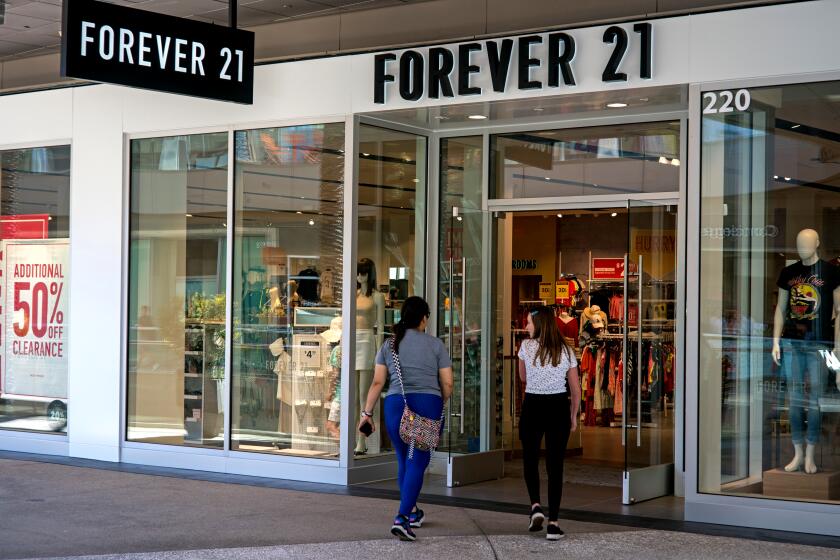Buying Into E-Commerce
- Share via
Every teenager who has ever worked at a grease trap knows how to say it: “Would you like fries with that?”
But online retailers are proving to be slow learners. They know how to build a store, but most have forgotten how to sell. Until they remember, Web surfers may buy a few things, but they won’t really shop.
Lost among the technology in online stores has been the marketing and merchandising commonly found in real-world stores. Even after a watershed holiday shopping season, only the top-tier online retailers have even begun to turn directed buyers of specific products into impulse-buying, mall-wandering, credit-limit-busting shoppers.
“If you’re shopping, it has to be a delight, and no one is using the word ‘delight’ when they’re talking about shopping online,” said Nancy Dickenson of Scient Corp., a San Francisco electronic business consulting firm.
Online retailers know how to get customers to come to their stores and have even convinced most people that it’s safe to send their credit card number over the Internet. But even after customers put something in a virtual shopping cart, seven out of 10 times the register doesn’t ring, industry watchers say.
Industrywide, only 1.6% of visits to an online retailer turn into a sale, according to Shop.org, an online retailing association. That figure is comparable to direct mail, an industry with a notoriously low response rate.
Mainstream customers are finding that Web sites designed by technologists take too long to download, ask for too much information and are difficult to navigate.
Also, the vast majority of online retailers are losing sales by failing to communicate the Internet equivalent of retailing basics such as “Those pants look nice on you” or “How about a shirt to go with those trousers?”
“Selling on the Web began like librarians creating effective ways of finding things, as opposed to businesspeople creating stores for selling things,” said Vahe Katros, director of retail applications at Blue Martini Software, a San Mateo, Calif.-based Internet commerce software developer.
The metaphor for most Web stores is “searching,” but real-world stores encourage “wandering” and “impulse buys.” High-margin products are placed on shelves at eye level or at the front of a store. Grocers have found that putting pasta in the same aisle as the pasta sauce increases sales of both.
Because technology enables online retailers to collect a tremendous amount of data on shoppers, the Internet has the potential for micro-merchandising--presenting a store based on an individual’s preferences after analyzing the data stream from previous visits or visits to other sites.
“The first generation of Web sites was testing the waters,” Katros said. “It’s only now where they’re beginning to refocus their efforts and try to leverage the skills and talents they have in selling to consumers.”
The little things that annoy shoppers on the Web can reduce sales, and retailers who have been on the Internet for a while have learned a few lessons.
MotherNature.com Inc. has been selling vitamins and nutritional supplements on the Internet since 1995 but still gets surprised by focus groups of new computer users.
“We put all these novices in front of our site in focus groups, and we can’t believe what they do,” said Michael Barach, president and chief executive of the Acton, Mass., company. “It blows your mind.”
For example, customers filling out the shipping address form on the MotherNature.com Web site would be asked for the two-letter abbreviation for their state, with a drop-down box listing the 50 codes. When the customer typed his or her state’s first letter into the box, the first state that began with that letter would appear. When the customer typed the second letter, the drop-down box would bring up a state that began with that letter. Thus, someone trying to type MN for Minnesota ends up with Nebraska instead.
“They hadn’t experienced a drop-down menu before and didn’t understand how it works,” Barach said. MotherNature.com customers are now just asked to type the state abbreviation into a plain box.
Customers flooded Proflowers Inc.’s Web site over the holidays, causing credit card processing to slow to a crawl.
“It was killing us,” said Barbara Bry, vice president of marketing and business development at the San Diego flower retailer. “It was the slowest part of the process for us.”
The company has since changed credit card verification vendors to tackle what many see as one of the main reasons Web sites lose customers: speed.
“People have a very low toleration for frustration on the Internet,” said David Pecaut, senior vice president of Boston Consulting Group, which conducted the Shop.org study. “On the telephone, they might be able to tolerate a certain number of hiccups. But on the Internet, they’ll wait five seconds, 10 at the most.”
Poor design sometimes forces customers to click through numerous Web pages before finding or ordering their item, when five clicks is optimal for a first-time customer, Dickenson said.
Online retailing pioneer Amazon.com is credited with eliminating forms altogether for repeat customers, creating a process by which they can purchase an item with just one click of a mouse, an innovation that has since been mimicked by others.
Simply informing customers of how far they are in the purchasing process can help, sort of like being able to tell how long the checkout line is at the grocery store.
The mainstream has taken to the Internet, and it tends to be less forgiving of computer idiosyncrasies that were accepted by early adopters, said Julie Wainwright, chief executive of Reel.com, an Emeryville, Calif., online movie store. Also, the two dozen or so top-tier online retailers hold such a large lead in quality that computer users have little tolerance for those that don’t meet those standards, Wainwright said.
“There will be a shakeout because people will be abandoning sites that don’t work well,” Wainwright said.
The promise of online selling has been that a merchant would be able to offer shoppers a customized experience, but few stores take advantage of that ability.
“E-commerce has been done very poorly because there hasn’t been any intelligence built into the site itself,” said Russell Yanda, co-founder of MatchLogic Inc., a Westminster, Colo.-based Internet marketing firm that’s now part of Internet portal Excite.
Most online retailers have collected gigabytes of data about their customers, including which products they’ve looked at and passed up, what they liked enough to place in their virtual shopping carts but later decided not to buy and what sort of things they’ve bought.
But few retailers have analyzed that data and used it in designing their stores so that, for example, a person who visited an online music store and passed on the five CDs shown on the store’s home page would see five different selections the next time he logged on.
Essentially, the online stores too often do a poor job of selling.
“If you and I were at a stereo store and were staring at equalizers with a dumb look on our faces, at a decent store, sooner or later someone would come up and ask if we needed help,” said Christopher Lochhead of Scient.
Software from the likes of Needham, Mass.-based Servicesoft Technologies Inc. and PeopleSupport Inc. in Los Angeles are just beginning to enter the market, offering real-time customer service online through text chat programs.
For most Web retailers, cross-selling, the equivalent of asking if the gentleman would like a tie to go with that suit he just purchased, seems to be a lost art. Rare is the online computer store that, when a customer buys a hand-held computer, offers to sell a leather carrying case, which sometimes carries a better profit margin than the computer.
It’s not as if the technology doesn’t exist. Eden Prairie, Minn.-based Net Perceptions Inc. for several years has offered software that makes online recommendations to customers based on buying patterns of other visitors who purchased the same item.
In fact, aside from the speed of Internet connections, technology is rarely the main reason visitors click away from a store, experts say.
Instead, online retailers just haven’t made the experience fulfilling enough, and, just as in the real world, the experience is where the next battleground lies.
“At Borders Books and Barnes & Noble, the books are essentially the same, and they’re competing on the basis of having the best lattes and soft, cushy chairs,” said Charles Wilson, managing director of the Minneapolis interactive marketing firm AisleFive. “In a low-contact environment like the Internet, what makes one Web store better than another, other than price, is something that’s very much being explored still.”
*
Times staff writer Jonathan Gaw can be reached via e-mail at jonathan.gaw@latimes.com.










